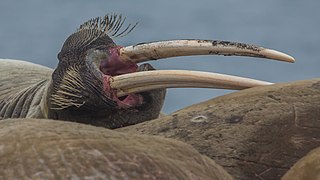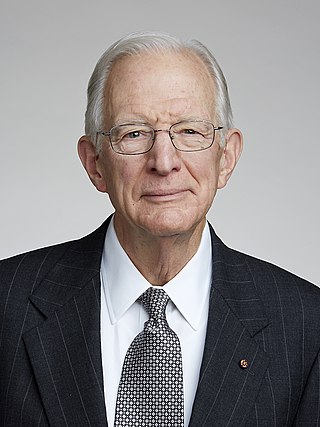Geochemistry is the science that uses the tools and principles of chemistry to explain the mechanisms behind major geological systems such as the Earth's crust and its oceans. The realm of geochemistry extends beyond the Earth, encompassing the entire Solar System, and has made important contributions to the understanding of a number of processes including mantle convection, the formation of planets and the origins of granite and basalt. It is an integrated field of chemistry and geology.

Bioturbation is defined as the reworking of soils and sediments by animals or plants. It includes burrowing, ingestion, and defecation of sediment grains. Bioturbating activities have a profound effect on the environment and are thought to be a primary driver of biodiversity. The formal study of bioturbation began in the 1800s by Charles Darwin experimenting in his garden. The disruption of aquatic sediments and terrestrial soils through bioturbating activities provides significant ecosystem services. These include the alteration of nutrients in aquatic sediment and overlying water, shelter to other species in the form of burrows in terrestrial and water ecosystems, and soil production on land.

The important sulfur cycle is a biogeochemical cycle in which the sulfur moves between rocks, waterways and living systems. It is important in geology as it affects many minerals and in life because sulfur is an essential element (CHNOPS), being a constituent of many proteins and cofactors, and sulfur compounds can be used as oxidants or reductants in microbial respiration. The global sulfur cycle involves the transformations of sulfur species through different oxidation states, which play an important role in both geological and biological processes. Steps of the sulfur cycle are:
In biogeochemistry, remineralisation refers to the breakdown or transformation of organic matter into its simplest inorganic forms. These transformations form a crucial link within ecosystems as they are responsible for liberating the energy stored in organic molecules and recycling matter within the system to be reused as nutrients by other organisms.

Dissolved organic carbon (DOC) is the fraction of organic carbon operationally defined as that which can pass through a filter with a pore size typically between 0.22 and 0.7 micrometers. The fraction remaining on the filter is called particulate organic carbon (POC).

Paleolimnology is a scientific sub-discipline closely related to both limnology and paleoecology. Paleolimnological studies focus on reconstructing the past environments of inland waters using the geologic record, especially with regard to events such as climatic change, eutrophication, acidification, and internal ontogenic processes.

A carbon-to-nitrogen ratio is a ratio of the mass of carbon to the mass of nitrogen in organic residues. It can, amongst other things, be used in analysing sediments and soil including soil organic matter and soil amendments such as compost.
Phytane is the isoprenoid alkane formed when phytol, a chemical substituent of chlorophyll, loses its hydroxyl group. When phytol loses one carbon atom, it yields pristane. Other sources of phytane and pristane have also been proposed than phytol.
Donald Eugene Canfield is a geochemist and Professor of Ecology at the University of Southern Denmark known for his work on the evolution of Earth's atmosphere and oceans. The Canfield ocean, a sulfidic partially oxic ocean existing during the middle of the Proterozoic eon, is named after him.
Professor Henry "Harry" Elderfield, was Professor of Ocean Chemistry and Palaeochemistry at the Godwin Laboratory in the Department of Earth Sciences at the University of Cambridge. He made his name in ocean chemistry and palaeochemistry, using trace metals and isotopes in biogenic carbonate as palaeochemical tracers, and studying the chemistry of modern and ancient oceans - especially those of the glacial epoch and the Cenozoic.
The Cenomanian-Turonian boundary event, also known as the Cenomanian-Turonian extinction, Cenomanian-Turonian Oceanic Anoxic Event, and referred to also as the Bonarelli Event or Level, was an anoxic extinction event in the Cretaceous period. The Cenomanian-Turonian oceanic anoxic event is considered to be the most recent truly global oceanic anoxic event in Earth's geologic history. There was a large carbon cycle disturbance during this time period, signified by a large positive carbon isotope excursion. However, apart from the carbon cycle disturbance, there were also large disturbances in the ocean's nitrogen, oxygen, phosphorus, sulphur, and iron cycles.

The oceanic carbon cycle is composed of processes that exchange carbon between various pools within the ocean as well as between the atmosphere, Earth interior, and the seafloor. The carbon cycle is a result of many interacting forces across multiple time and space scales that circulates carbon around the planet, ensuring that carbon is available globally. The Oceanic carbon cycle is a central process to the global carbon cycle and contains both inorganic carbon and organic carbon. Part of the marine carbon cycle transforms carbon between non-living and living matter.

Particulate organic matter (POM) is a fraction of total organic matter operationally defined as that which does not pass through a filter pore size that typically ranges in size from 0.053 millimeters (53 μm) to 2 millimeters.

John Michael Hayes was an American oceanographer. He worked at Indiana University Bloomington, and Woods Hole Oceanographic Institution in Woods Hole, Massachusetts.

Marine biogeochemical cycles are biogeochemical cycles that occur within marine environments, that is, in the saltwater of seas or oceans or the brackish water of coastal estuaries. These biogeochemical cycles are the pathways chemical substances and elements move through within the marine environment. In addition, substances and elements can be imported into or exported from the marine environment. These imports and exports can occur as exchanges with the atmosphere above, the ocean floor below, or as runoff from the land.
Euxinia or euxinic conditions occur when water is both anoxic and sulfidic. This means that there is no oxygen (O2) and a raised level of free hydrogen sulfide (H2S). Euxinic bodies of water are frequently strongly stratified; have an oxic, highly productive, thin surface layer; and have anoxic, sulfidic bottom water. The word "euxinia" is derived from the Greek name for the Black Sea (Εὔξεινος Πόντος (Euxeinos Pontos)) which translates to "hospitable sea". Euxinic deep water is a key component of the Canfield ocean, a model of oceans during part of the Proterozoic eon (a part specifically known as the Boring Billion) proposed by Donald Canfield, an American geologist, in 1998. There is still debate within the scientific community on both the duration and frequency of euxinic conditions in the ancient oceans. Euxinia is relatively rare in modern bodies of water, but does still happen in places like the Black Sea and certain fjords.
Carbonate-associated sulfates (CAS) are sulfate species found in association with carbonate minerals, either as inclusions, adsorbed phases, or in distorted sites within the carbonate mineral lattice. It is derived primarily from dissolved sulfate in the solution from which the carbonate precipitates. In the ocean, the source of this sulfate is a combination of riverine and atmospheric inputs, as well as the products of marine hydrothermal reactions and biomass remineralisation. CAS is a common component of most carbonate rocks, having concentrations in the parts per thousand within biogenic carbonates and parts per million within abiogenic carbonates. Through its abundance and sulfur isotope composition, it provides a valuable record of the global sulfur cycle across time and space.
Cindy Lee is a retired Distinguished Professor known for her research characterizing the compounds that comprise marine organic matter.
Global paleoclimate indicators are the proxies sensitive to global paleoclimatic environment changes. They are mostly derived from marine sediments. Paleoclimate indicators derived from terrestrial sediments, on the other hand, are commonly influenced by local tectonic movements and paleogeographic variations. Factors governing the Earth's climate system include plate tectonics, which controls the configuration of continents, the interplay between the atmosphere and the ocean, and the Earth's orbital characteristics. Global paleoclimate indicators are established based on the information extracted from the analyses of geologic materials, including biological, geochemical and mineralogical data preserved in marine sediments. Indicators are generally grouped into three categories; paleontological, geochemical and lithological.
Elizabeth A. Canuel is a chemical oceanographer known for her work on organic carbon cycling in aquatic environments. She is the Chancellor Professor of Marine Science at the College of William & Mary and is an elected fellow of the Geochemical Society and the European Association of Geochemistry.









